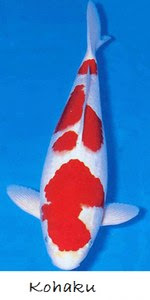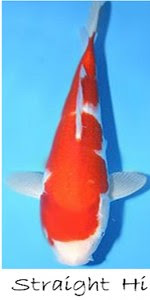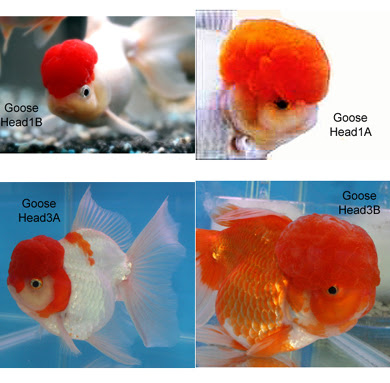Kohaku
Kohaku
An excerpt from a post that originally appeared on http://caribbeannishikigoi.com/
Kohaku is one of the most beautiful and popular Koi in the world. It is very simple, yet very
elegant variety. It has been said that most of the hobbyist started and
finished with the Kohaku.
Kohaku means red and white and was established in Japan in early 1800. During that time, Japanese rice farmers observed a red and white mutations started occurring within the common carp. Then, in 1888, Mr. Kunizo Hiroi bred a female Koi with redheaded marking similar to cherry blossoms. After that, all of the well known Kohaku bloodlines were established.
Kohaku is one of the most beautiful and popular Koi in the world. It is very simple, yet very elegant variety. It has been said that most of the hobbyist started and finished with the Kohaku.
Kohaku are white Koi with red markings. Its value depends on the white skin, since it should be pure, no yellowing, with no stains or other blemishes. Also the intensity of red patterns should be artistically well-balanced. In regards with the edges of the red markings, it must be sharp and clear against the white backgrounds. However, take into consideration that in very young Koi the red starts out as a pale yellow, then changes to orange and finally to a beautiful red.
In general, Kohaku are sensitive to water conditions. In fact, in hard water they can develop shimi or small black freckles on their skin. But don't worry, because the soft water can control black freckles from forming. Most, of the hobbyists preferred female Kohaku because of their larger body. They are also likely to have a truly lustrous red pattern last longer than with males. The reason behind that, males tend to develop the red colors faster than females. However, their pattern also diminishes easier and does not last longer than females.
There are hundreds of red patterns available in the market today, but let me provide you some of the popular Kohaku.
Tancho, is a pure white Koi with a single red crown-like marking on the head between the eyes. Maruten is similar to Tancho but aside from single roundish red marking in the center of the head, it also has red markings on the rest of the body. Next is, Ohmoyo. It is a large and unbroken one step pattern extending from head to tail. Then, Nidan is a two step pattern that are not interconnected. While, Straight Hi is interconnected red patches of a single and continuous Hi pattern.
Tancho koi Maruten Koi
One of the most popular is Sandan with three step pattern. The four step is called Yondan pattern and the five step is known as Godan pattern. On the other hand, Inazuma is a zigzag pattern that has resemblance to a lightning strike. Another type of recognized patterns is Kuchibeni. It is so unique by having red on a mouth similar to a red lipstick.
An excerpt from a post that originally appeared on http://caribbeannishikigoi.com/
Kohaku is one of the most beautiful and popular Koi in the world. It is very simple, yet very
elegant variety. It has been said that most of the hobbyist started and
finished with the Kohaku.
Kohaku means red and white and was established in Japan in early 1800. During that time, Japanese rice farmers observed a red and white mutations started occurring within the common carp. Then, in 1888, Mr. Kunizo Hiroi bred a female Koi with redheaded marking similar to cherry blossoms. After that, all of the well known Kohaku bloodlines were established.
Kohaku is one of the most beautiful and popular Koi in the world. It is very simple, yet very elegant variety. It has been said that most of the hobbyist started and finished with the Kohaku.
Kohaku are white Koi with red markings. Its value depends on the white skin, since it should be pure, no yellowing, with no stains or other blemishes. Also the intensity of red patterns should be artistically well-balanced. In regards with the edges of the red markings, it must be sharp and clear against the white backgrounds. However, take into consideration that in very young Koi the red starts out as a pale yellow, then changes to orange and finally to a beautiful red.
In general, Kohaku are sensitive to water conditions. In fact, in hard water they can develop shimi or small black freckles on their skin. But don't worry, because the soft water can control black freckles from forming. Most, of the hobbyists preferred female Kohaku because of their larger body. They are also likely to have a truly lustrous red pattern last longer than with males. The reason behind that, males tend to develop the red colors faster than females. However, their pattern also diminishes easier and does not last longer than females.
There are hundreds of red patterns available in the market today, but let me provide you some of the popular Kohaku.
Tancho, is a pure white Koi with a single red crown-like marking on the head between the eyes. Maruten is similar to Tancho but aside from single roundish red marking in the center of the head, it also has red markings on the rest of the body. Next is, Ohmoyo. It is a large and unbroken one step pattern extending from head to tail. Then, Nidan is a two step pattern that are not interconnected. While, Straight Hi is interconnected red patches of a single and continuous Hi pattern.
Tancho koi Maruten Koi
One of the most popular is Sandan with three step pattern. The four step is called Yondan pattern and the five step is known as Godan pattern. On the other hand, Inazuma is a zigzag pattern that has resemblance to a lightning strike. Another type of recognized patterns is Kuchibeni. It is so unique by having red on a mouth similar to a red lipstick.












Comments
Post a Comment